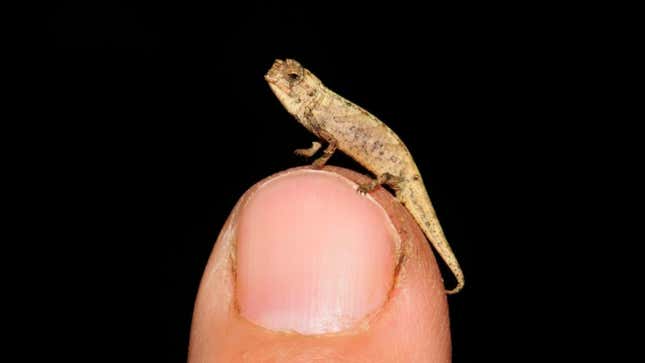
Researchers have found a minuscule chameleon in Northern Madagascar, which they believe to be the smallest reptile on the planet. Small body, big attitude—just look at that face.
The chameleon is Brookesia nana, abbreviated to B. nana (if you squint, it does kind of look like a banana). Females of the species are larger than males, at about three-quarters of an inch from snout to vent. The new record holders are the adult males, which are less than an inch including the tail. Oh, and the males also have huge hemipenes (genitals) in proportion to their size. The team’s findings were published today in the journal Scientific Reports.

“The extremely miniaturized males of the small species need relatively larger genitals,” said co-author Miguel Vences of the Technical University of Braunschweig, in a Bavarian Natural History Collections press release, “in order to successfully mate with the larger females.”
Most of the tiny chameleon’s relatives in the genus Brookesia are similarly small and live in the northern forests of Madagascar. Though B. nana is tiny, its genitals needed to keep up with reproductive expectations (and necessities). While chameleons, it’s worth noting that the entire family of Brookesia doesn’t have much capacity for color-changing—that behavior is mostly limited to the bigger lizards in the family Chamaeleonidae, according to study co-author Mark Scherz, a herpetologist and evolutionary biologist at the University of Potsdam in Germany.
As Scherz explained in a Twitter thread, it’s not easy to find these little crawlers. The searching is done at night, when the chameleons roost on branches above the forest floor. The researchers often rely on local guides like Angeluc Razafimanantsoa, whose skills at finding such hard-to-spot species are unparalleled.

As for why B. nana got so nano, one might be tempted to turn to the island rule, which describes how, when isolated (say, on an island), animals sometimes grow much larger or smaller than their non-isolated relatives. (Once, wolf-sized elephants walked on Malta, and 12-foot-tall birds called moas roamed New Zealand).
“There are numerous extremely miniaturized vertebrates in Madagascar, including the smallest primates and some of the smallest frogs in the world, which have evolved independently,” said co-author Andolalao Rakotoarison, a herpetologist at the University of Antananarivo in Madagascar, in the same release.

Convergent miniaturization on Madagascar doesn’t mean that the same process was at play across all species, though. The team notes that the island rule doesn’t apply to many lizards, and the nano-chameleon’s habitat—inland in a high-altitude montane rainforest—may not precipitate such dwarfism. Scherz said that other factors could be at play.
“If relative resource availability is greater at small body size (either because of competition or because of natural resource abundance), it can be worth it to get smaller,” he wrote in an email. “If predation pressure on an animal decreases at smaller size, that could also be an advantage, although that’s harder to imagine.”
The researchers mention that while the species’ habitat is currently intact, it may be threatened, as deforestation is rampant on Madagascar. Economic development would be an important step in reducing the sort of slash-and-burn agriculture that eats away at the habitat of so many species, Scherz said.
Recently, the habitat of B. nana was declared a protected area, which hopefully will stall, if not completely stave off, threats to the little lizard. If there’s one thing we hopefully can all agree on, it’s that the world is richer for having such an itsy-bitsy branch on the tree of life.